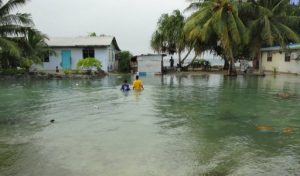Pacific Islands are facing a triple threat due to climate change: accelerating sea level rise, ocean warming, and acidification. These escalating challenges are jeopardising not only the socioeconomic stability of these islands but also their existence, highlights a new WMO report.

The World Meteorological Organisation (WMO) State of the Climate in the South-West Pacific 2023 report details how sea level rise in the region is above the global average. In much of the western tropical Pacific, sea level has risen approximately 10–15 cm, close to or nearly twice the global rate measured since 1993. In the central tropical Pacific, sea level has risen approximately 5–10 cm.
In addition, sea surface temperatures have risen three times faster than the global average since 1980. During that time marine heatwaves have approximately doubled in frequency since 1980 and are more intense and are lasting longer.
The report was released by United Nations Secretary-General, António Guterres, and WMO Secretary-General, Celeste Saulo, at the Pacific Islands Forum in Tonga. It was accompanied by a special briefing document on Surging Seas in a Warming World, described by Mr Guterres as “an SOS on sea level rise.”
He also noted that Pacific Islands are particularly exposed to the consequences of climate change, despite accounting for just 0.02% of global emissions. Their average elevation is just one to two metres above sea level; 90% of the population live within 5 kilometres of the coast and half the infrastructure is within 500 metres of the sea.
The State of the Climate in the South-West Pacific 2023 report was prepared in cooperation with National Meteorological and Hydrological Services, the United Nations Economic and Social Commission for Asia and the Pacific (ESCAP) and other United Nations agencies and international partners. It also looks at climate drivers in 2023 – including the last El Niño event – temperature, precipitation and extreme events such as tropical cyclones, drought and extreme heat in the region.
Overall, 34 reported hydrometeorological hazard events in 2023 – most of them storm or flood related – led to over 200 fatalities and impacted more than 25 million people in the region.
“Climate change has become a global crisis and is the defining challenge that humanity currently faces. Communities, economies and ecosystems throughout the South-West Pacific region are significantly affected by its cascading impacts. It is increasingly evident that we are fast running out of time to turn the tide,” said Saulo.
